10 Space-Saving Vertical Container Gardens for Tiny Balconies
- Hanging Gutter Gardens – Transform ordinary rain gutters into stylish hanging planters. Mount them on your balcony railing or wall to create linear gardens perfect for growing herbs or strawberries. These lightweight containers maximize vertical space while providing adequate drainage for your plants.
- Pocket Shoe Organizers – Repurpose fabric shoe organizers into living walls of greenery. Fill each pocket with soil and small plants like succulents, herbs, or trailing flowers. Hang it on your balcony wall or railing to instantly add vertical garden space without taking up valuable floor area.
- Tiered Plant Stands – Invest in multi-level plant stands that stack containers vertically. These space-efficient structures can hold multiple pots while maintaining a small footprint. Choose a corner placement to maximize your balcony’s usable space while showcasing plants at different heights.
- Railing Planter Boxes – Install specially designed containers that hook directly onto your balcony railings. These planters hang on the outside of your railing, effectively creating new gardening space without encroaching on your limited floor area. Perfect for colorful annuals or a practical herb garden.
- Trellis Container Systems – Set up containers with built-in trellises or add separate trellises behind pots. This approach encourages climbing plants like peas, beans, or morning glories to grow upward. The vertical growth pattern provides greenery, food, and even shade without cluttering your balcony floor.
- Stacked Tower Planters – Try vertical tower planters with multiple planting pockets spiraling around a central column. These innovative containers can hold dozens of plants in a single square foot of space. They’re ideal for strawberries, lettuce, herbs, and flowering plants that don’t need deep root systems.
- Pallet Gardens – Upcycle wooden pallets by standing them vertically and filling the slats with soil and plants. Secure the pallet to your balcony wall for stability. This DIY approach creates an instant vertical garden perfect for succulents, small flowers, or herbs with minimal investment.
- Hanging Basket Tiers – Suspend multiple hanging baskets at different heights using ceiling hooks or a shepherd’s hook stand. Connect the baskets with chains to create a vertical column of plants. This arrangement draws the eye upward and transforms unused aerial space into a flourishing garden.
- Wall-Mounted Mason Jars – Attach mason jars to wooden boards using pipe clamps, then mount the boards on your balcony wall. Fill the jars with soil and herbs or small flowering plants. This charming and customizable solution adds greenery without taking up any floor space.
- Magnetic Miniature Pots – For metal railings or walls, consider tiny magnetic planters that stick directly to the surface. These micro-containers are perfect for air plants, small succulents, or individual herb plants. Arrange them in patterns to create living wall art that requires zero floor space.
7 Hanging Basket Solutions for Small Space Gardening
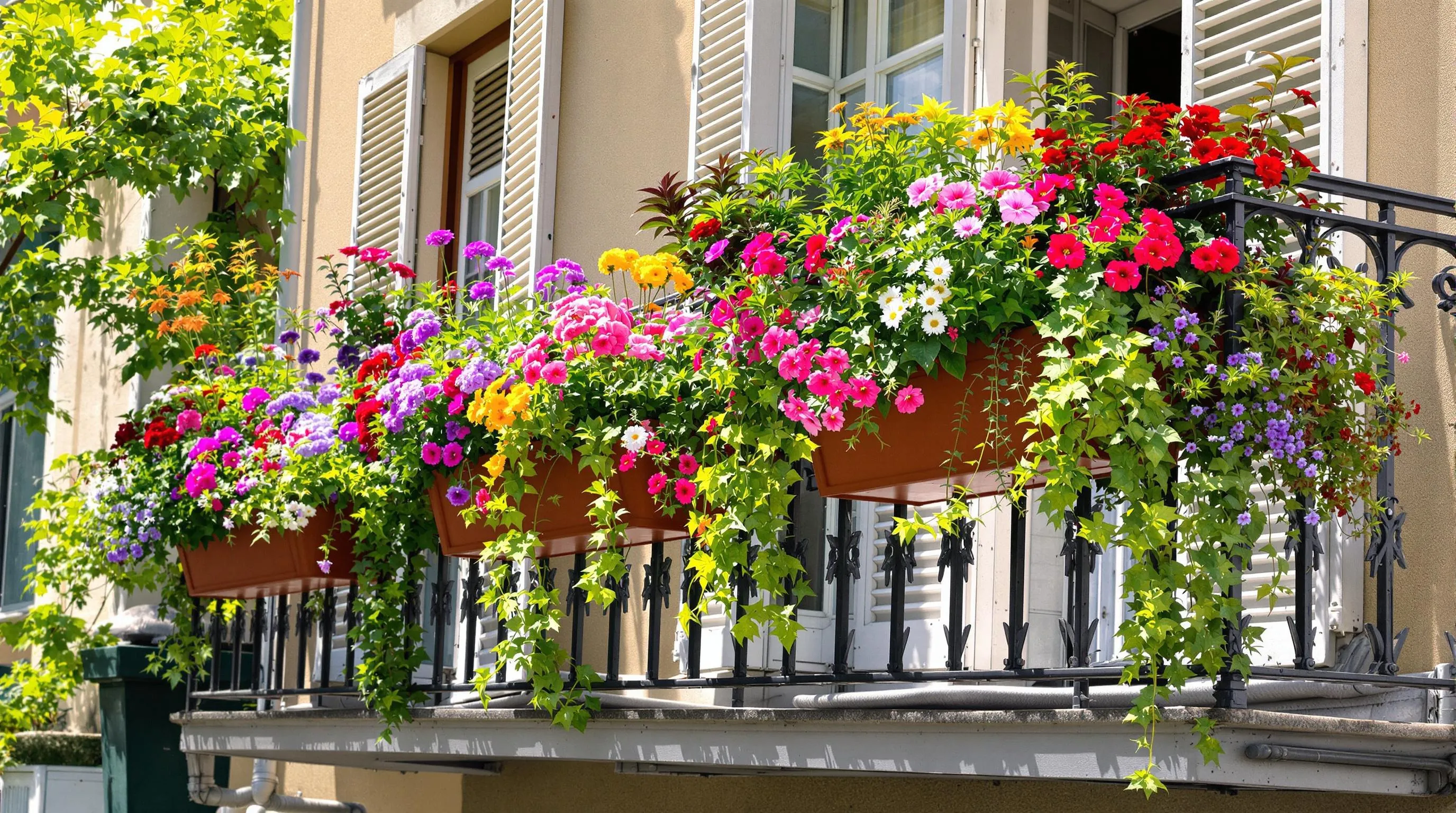
Hanging baskets offer a perfect solution for gardeners with limited space, allowing you to grow plants vertically and make use of overhead areas. These versatile containers can transform bare spaces into lush, green environments without taking up valuable floor space.
Macramé Plant Hangers for Indoor Herbs
Macramé plant hangers bring a touch of bohemian style to your indoor herb garden while maximizing vertical space. These handcrafted rope holders suspend your herb pots from the ceiling, creating an eye-catching display that keeps essential cooking herbs within easy reach. You can hang basil, mint, thyme, and oregano in sunny windows where they’ll thrive while adding natural beauty to your kitchen or living area. The varied lengths of macramé hangers allow you to create a cascading effect, with each herb positioned at the optimal height for its light requirements. For added functionality, choose macramé designs with multiple tiers to house several herb varieties in a single hanging unit.
Over-the-Railing Planters That Maximize Balcony Space
Over-the-railing planters transform unused balcony railings into productive growing space without sacrificing your limited floor area. These specially designed containers hook or clamp securely onto railings, creating an instant garden right at the edge of your balcony or deck. Most models feature adjustable brackets that fit various railing widths and include drainage systems to prevent water damage. You can grow trailing flowers like petunias and lobelia that cascade downward, or practical vegetables such as lettuce, radishes, and compact tomato varieties. The placement of these planters also makes maintenance easy—you won’t need to bend down to water or harvest your plants. For a cohesive look, select planters in colors that complement your outdoor décor or use multiple planters in a row to create a privacy screen of greenery.
8 Window Box Ideas to Transform Your Apartment Views

Herb Window Boxes for Kitchen Windows
Transform your kitchen window into a functional herb garden with custom window boxes. Mount simple wooden or plastic containers directly beneath your window for easy access to fresh herbs while cooking. Choose compact varieties like chives, thyme, basil, and oregano that thrive in partial sunlight. Install a tiered window box system to maximize space and grow multiple herb types in one location. For apartments with limited natural light, add small grow lights to ensure your herbs receive 6-8 hours of light daily. Use fast-draining soil mixtures specifically designed for herbs to prevent root rot in the confined space of window boxes.
Colorful Flower Combinations for Curb Appeal
Create stunning visual impact with strategic flower combinations in your window boxes. Pair trailing plants like ivy or sweet potato vine with upright blooms such as geraniums and petunias for dimensional appeal. Follow the “thriller, filler, spiller” method by placing taller plants in the center, medium-sized fillers around them, and cascading varieties at the edges. Choose complementary colors for maximum visual effect—try purple and yellow or red and white combinations for eye-catching contrast. Select flowers with different blooming periods to ensure continuous color throughout growing seasons. For north-facing windows, opt for shade-loving options like impatiens, begonias, and coleus that will thrive without direct sunlight.
12 Upcycled Container Ideas for Budget-Friendly Urban Gardens
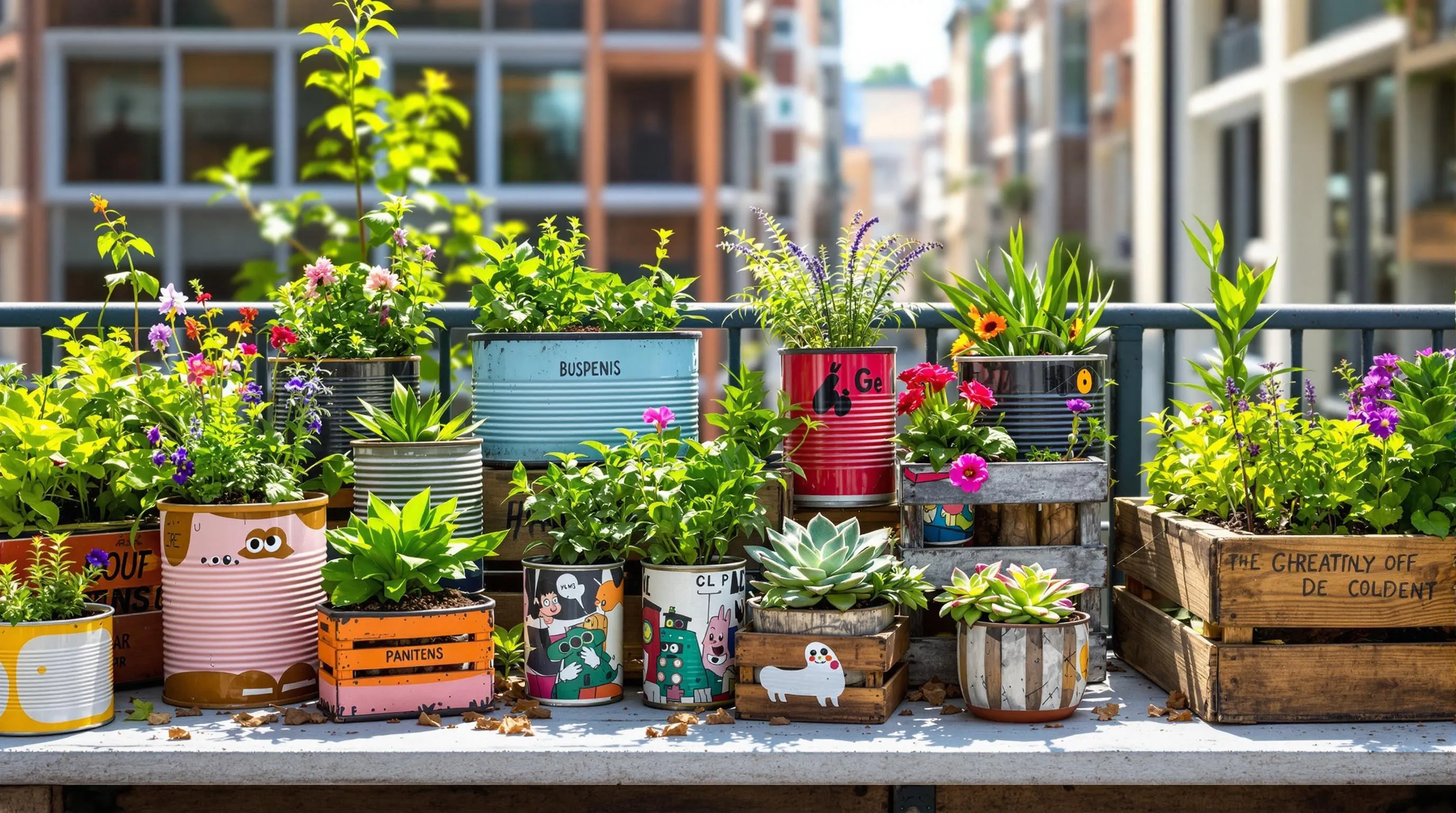
Repurposed Household Items as Unique Planters
Transform everyday household items into charming planters to reduce waste and save money. Old teapots make whimsical herb containers, while chipped mugs work perfectly for small succulents. Repurpose worn-out colanders as hanging baskets with built-in drainage, and convert unused kitchen pots into homes for larger plants. Wooden crates can become stylish planters after a quick coat of weather-resistant paint. Even tin cans from your pantry can be decorated with paint or fabric for an eco-friendly container. These repurposed items add personality to your garden while keeping your budget intact and giving new life to objects that would otherwise end up in landfills.
DIY Pallet Planters for Vertical Growing
Wooden pallets offer an excellent foundation for vertical gardens in tight spaces. Start by sanding rough edges and applying a non-toxic sealant to protect the wood from moisture. Attach industry fabric to the back and bottom using a staple gun, creating pockets for soil and plants. Mount your pallet planter securely on a sunny wall, filling the pockets with herbs, strawberries, or trailing flowers. For extra stability, reinforce the structure with L-brackets. Pallets work particularly well for shallow-rooted plants like lettuce, succulents, and annual flowers. This vertical solution maximizes growing space while adding a rustic, industrial charm to urban balconies or tiny patios.
Wine Crate Herb Gardens
Wine crates provide the perfect depth and width for compact herb gardens. Their sturdy construction and attractive wood grain add rustic charm to any kitchen counter or balcony. Drill several drainage holes in the bottom, add a layer of gravel, then fill with quality potting soil. Plant Mediterranean herbs like rosemary, thyme, and oregano together as they share similar water and sunlight requirements. For visual interest, arrange taller herbs in the center with cascading varieties along the edges. The portability of wine crates allows you to follow the sun or bring herbs indoors during harsh weather, ensuring year-round access to fresh flavors.
Tin Can Succulent Gardens
Rescue tin cans from your recycling bin to create eye-catching succulent displays. Clean cans thoroughly, remove labels, and punch drainage holes in the bottoms using a hammer and nail. Sand any sharp edges before painting with rust-resistant outdoor paint in coordinating colors or patterns. Fill with cactus soil mix and plant a variety of small succulents with complementary textures and heights. Arrange your tin can garden on window sills, shelves, or hang from hooks using wire to maximize vertical space. This ultra-affordable container option costs virtually nothing while adding industrial-chic style to your small space garden.
Boot and Shoe Planters
Give worn-out footwear new purpose by transforming boots and shoes into quirky garden containers. Rain boots, work boots, and even old dress shoes make unexpected and whimsical planters. Drill drainage holes in the bottoms, fill with lightweight potting mix, and plant trailing flowers or compact herbs. Arrange boots on steps or hang from hooks to create vertical interest. Children’s outgrown footwear works particularly well for small succulents or alpine plants. This conversation-starting upcycling project adds personality to your garden while extending the life of items that would otherwise be discarded.
Drawer Gardens for Succulents
Repurpose old dresser drawers into shallow planting beds perfect for succulents and cacti. Leave the original hardware attached for vintage charm, and drill several drainage holes in the bottom. Apply wood sealer to protect against moisture, then fill with cactus potting mix. Arrange succulents in artful compositions, playing with different heights, colors, and textures. Stack multiple drawers on a tiered stand or arrange them on a wall for a living art installation. This creative container solution gives new life to furniture pieces that might otherwise end up in landfills while providing the perfect growing environment for drought-tolerant plants.
Ladder Plant Displays
Transform an old wooden ladder into a space-efficient vertical garden. Sand rough edges and apply exterior paint or wood sealer for weather protection. Position against a wall or railing, then place potted plants on each step to create a cascading display. Secure pots with adhesive strips or brackets to prevent tipping. Arrange plants by light requirements, with sun-lovers on top steps and shade-tolerant varieties below. A ladder display allows for easy rearrangement and maintenance while adding architectural interest to small patios or balconies. This vertical solution dramatically increases your growing capacity without consuming valuable floor space.
Hanging Bottle Gardens
Create vertical herb or flower gardens from plastic bottles for virtually no cost. Cut bottles horizontally, punch drainage holes in the bottoms, and hang with sturdy twine or wire in a sunny spot. For a more polished look, paint bottles with outdoor spray paint before planting. Fill with lightweight potting mix and small herbs or flowers that don’t require deep root space. Arrange multiple bottles at different heights for visual impact and to maximize growing area. This ultra-lightweight solution works well for rental properties as it creates minimal damage to supporting structures while utilizing otherwise unused vertical space.
Basket Wall Gardens
Mount wicker or wire baskets on walls or fences to create living wall art in small spaces. Line baskets with coconut coir or industry fabric to retain soil while allowing drainage. Secure to walls with appropriate anchors based on your wall material and the weight of your plants. Plant trailing varieties like string of pearls, ivy, or cascading petunias for dramatic effect. Arrange baskets in clusters or patterns for greater visual impact. This adaptable container solution works well for both indoor and outdoor spaces, transforming empty vertical surfaces into lush, living tapestries without consuming valuable floor area.
Upcycled Tire Planters
Transform discarded tires into durable, weather-resistant planters that add industrial flair to urban gardens. Clean tires thoroughly, then paint with bright colors using exterior latex paint for long-lasting finish. For a cleaner look, cut away one sidewall to create a deeper planting bowl. Fill with quality potting soil and plant vegetables with moderate root depth like peppers, eggplants, or bush beans. Stack multiple tires to create tiered planters for strawberries or cascading flowers. This eco-friendly solution diverts waste from landfills while providing excellent insulation for plant roots against temperature fluctuations.
Wooden Toolbox Herb Gardens
Vintage wooden toolboxes make charming containers for herb collections with their built-in handles for portability. Drill drainage holes in the bottom, add a layer of gravel, then fill with quality potting soil. The compartmentalized design naturally separates different herb varieties, preventing aggressive spreaders from overtaking their neighbors. Position on a sunny windowsill or balcony railing where herbs receive adequate light and remain accessible for cooking. The rustic appearance adds farmhouse charm to modern spaces while the sturdy construction ensures years of use as a functional garden container.
Glass Jar Terrariums
Create miniature ecosystems in repurposed glass jars and containers for indoor gardening with minimal space requirements. Clean jars thoroughly and arrange layers of small gravel, activated charcoal, and potting soil for proper drainage. Select miniature ferns, mosses, and other humidity-loving plants that thrive in enclosed environments. Group jars of different heights and shapes on shelves or windowsills for an artistic display. These self-contained gardens require minimal maintenance while adding greenery to even the smallest apartments. Their sealed nature makes them ideal for environments where traditional potted plants might create mess or trigger allergies.
6 Stackable Container Systems to Maximize Growing Area
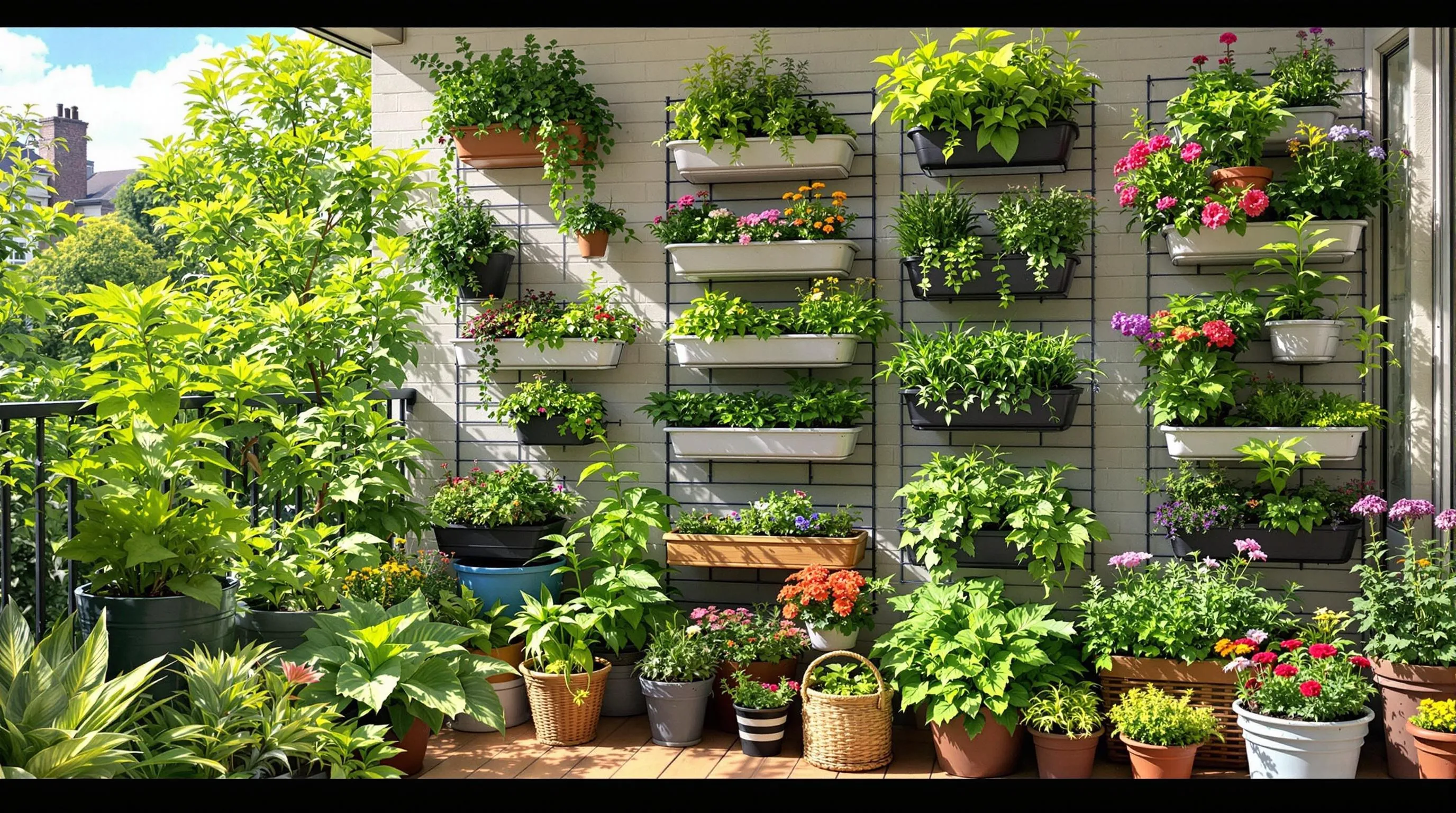
1. Vertical Tower Planters
Vertical tower planters are perfect for growing multiple plants in a minimal footprint. These systems typically feature a central structure with planting pockets arranged around the sides, allowing you to grow up to 50 plants in just one square foot of floor space. Most tower planters work best with herbs, strawberries, and leafy greens like lettuce and spinach. Position these towers in sunny spots on balconies or patios where they’ll receive at least 6 hours of sunlight daily for optimal growth.
2. Tiered Plant Shelves
Tiered shelving systems create instant vertical growing space by stacking multiple growing levels. These versatile units can accommodate 15-20 containers while occupying minimal floor space. Look for adjustable shelves that let you customize heights for different plants—taller plants on bottom shelves, compact herbs and flowers on upper levels. Many modern designs feature wheels for easy repositioning to follow sunlight patterns throughout the day.
3. Stacking Pots
Stacking pot systems consist of containers that nest directly on top of each other, creating a compact vertical garden. These space-efficient designs typically include a central watering column that distributes moisture to all levels. Each stacking system can support 4-6 planting levels within a single container footprint. These work exceptionally well for strawberries, herbs, and flowering annuals like petunias and marigolds that don’t require deep root zones.
4. Wall-Mounted Pocket Systems
Wall-mounted pocket systems transform unused vertical wall space into productive growing areas. These fabric or rigid plastic pocket arrays can hold 9-25 plants depending on the size. The modular design allows you to expand horizontally or vertically as space permits. Install these on sunny balcony walls, fence sections, or even indoor walls near bright windows. The pockets work best with shallow-rooted plants like lettuce, herbs, and trailing flowers.
5. Corner Pyramid Planters
Corner pyramid planters are ingeniously designed to fit into unused corner spaces while providing multiple planting tiers. These triangular structures feature 3-5 stacked growing levels that narrow toward the top, accommodating 10-15 plants in what would otherwise be wasted space. The stepped design ensures all plants receive adequate light while the corner placement maximizes spatial efficiency on balconies and patios.
6. Hydroponic Stacking Systems
Hydroponic stacking systems offer the ultimate space efficiency for small-space gardeners. These soilless growing towers can support 20-30 plants in a footprint smaller than two square feet. Most systems feature a nutrient reservoir at the base that pumps water to the top, which then trickles down through each planting module. These high-tech options work particularly well for leafy greens, herbs, and strawberries, producing harvests up to 30% faster than traditional soil containers while using 90% less water.
9 Herb Container Gardens Perfect for Tiny Kitchens
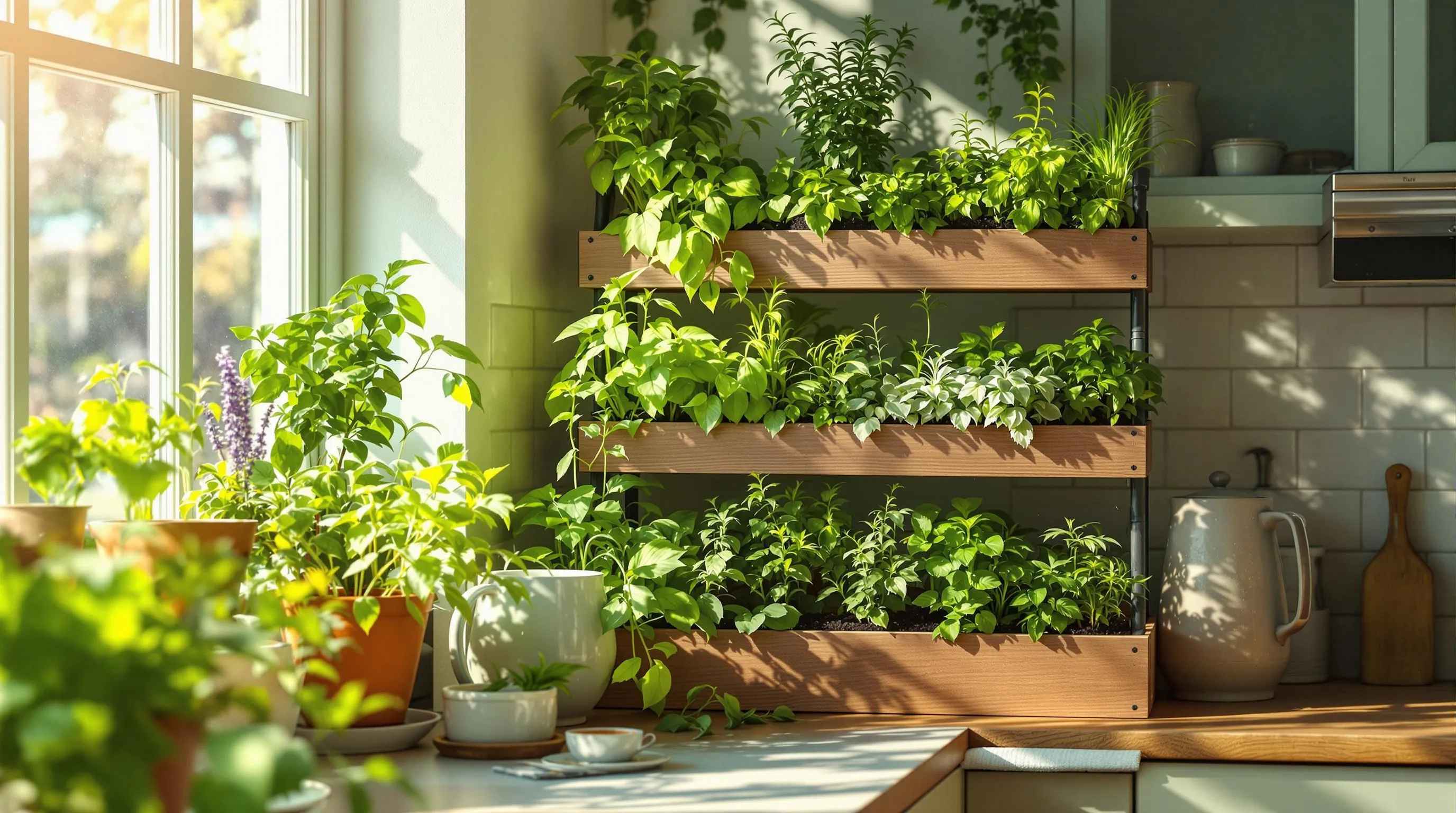
Space-Saving Tiered Herb Gardens
Maximize your tiny kitchen’s growing potential with tiered herb gardens that stack vertically rather than spread horizontally. These clever systems typically feature 2-3 levels of growing space, allowing you to grow multiple herbs in the footprint of a single pot. Position your tiered herb garden near a sunny window for optimal growth, arranging sun-loving herbs like basil and rosemary on the top tier and more shade-tolerant herbs like mint and parsley on lower levels. Many tiered options include drainage systems that prevent overwatering, with excess moisture from upper plants filtering down to nourish lower ones. For DIY enthusiasts, create your own tiered system using terra cotta pots in decreasing sizes or repurpose a small ladder-style shelf to hold individual herb containers.
Countertop Container Options for Fresh Cooking Herbs
Transform your kitchen countertop into a functional herb garden with compact container answers designed specifically for small spaces. Mason jar herb gardens offer an elegant yet practical approach—simply plant individual herbs in jars filled with potting mix and arrange them on a decorative tray for easy access while cooking. Self-watering containers eliminate the worry of under or overwatering, making them perfect for busy cooks. Look for specialized herb growing kits that include everything needed to get started, including seeds, soil, and containers sized perfectly for countertops. For a unified look, choose matching ceramic pots in colors that complement your kitchen décor. Position your countertop herbs near a window that receives at least 4-6 hours of sunlight daily, or supplement with small grow lights if natural light is limited. The most successful countertop herbs include chives, thyme, and cilantro, which thrive in smaller containers and provide frequent harvests for cooking.
5 Railing Planter Solutions for Balconies and Patios
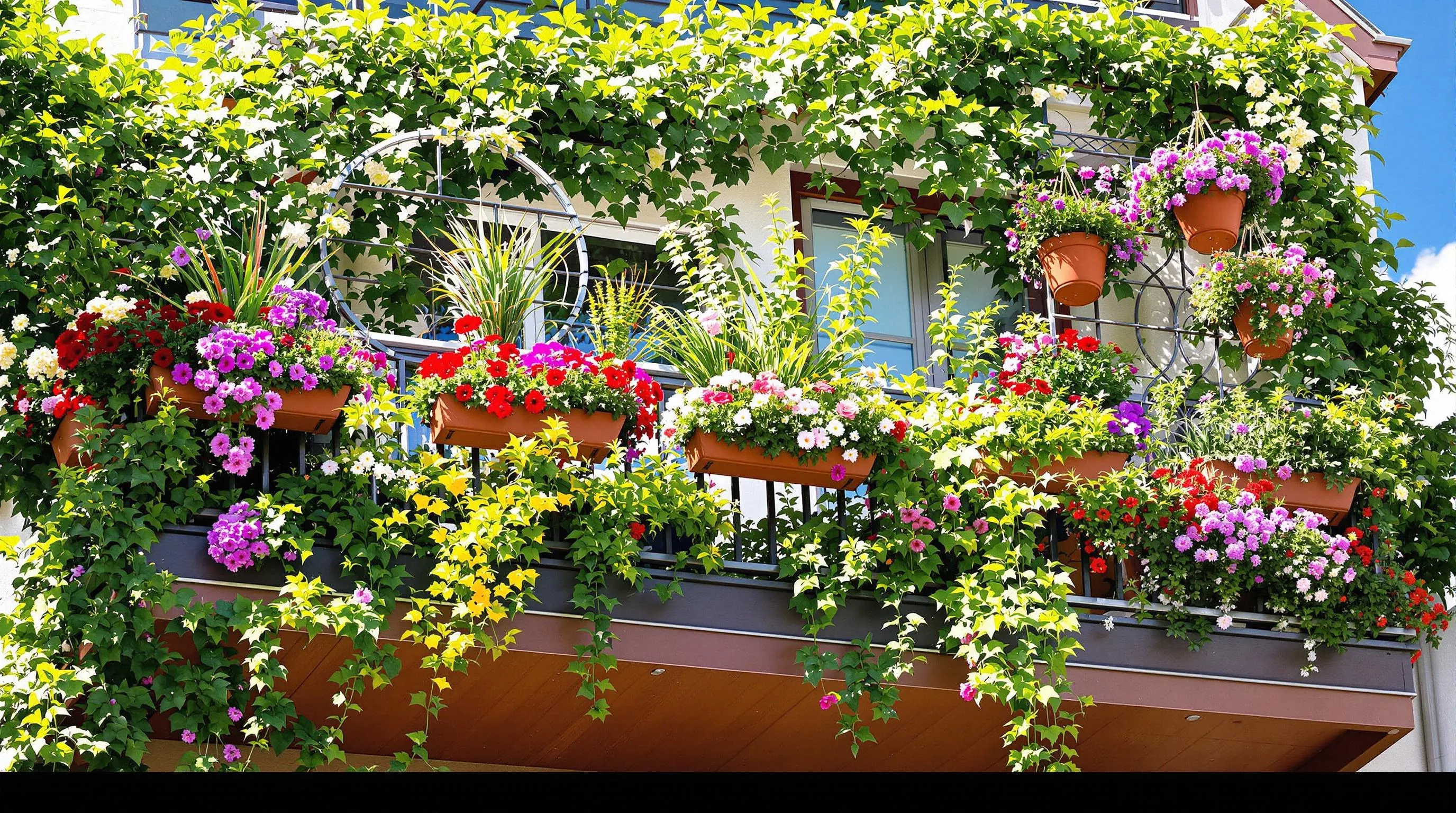
1. Saddle-Style Railing Planters
Saddle-style railing planters straddle your balcony railings, creating an instant garden without taking up precious floor space. These versatile containers typically feature a two-sided design that distributes weight evenly on both sides of the railing. Choose self-watering options to reduce maintenance and ensure your plants stay hydrated during hot summer days. Most saddle planters accommodate railings up to 4 inches wide and come in various materials like weather-resistant plastic, powder-coated metal, or natural fibers for aesthetic appeal.
2. Adjustable Railing Brackets
Transform any container into a railing planter with adjustable brackets that secure standard pots to your balcony or patio railings. These affordable metal fixtures can support containers weighing up to 10 pounds and typically adjust to fit railings between 1-4 inches thick. Install multiple brackets along your railing to create a customized display of different plants and containers. This solution offers maximum flexibility, allowing you to swap out seasonal plantings or rearrange your garden design whenever inspiration strikes.
3. Vertical Railing Trellis Systems
Maximize your growing space with railing-mounted trellis systems that extend your garden upward. These innovative structures attach securely to standard railings and provide support for climbing plants like peas, beans, cucumbers, or flowering vines such as morning glories or clematis. Look for modular trellis panels that can connect horizontally along your railing, creating a living privacy screen that adds both beauty and functionality to your small outdoor space while keeping floor space completely clear.
4. Tiered Railing Planters
Stack your garden vertically with tiered railing planters that multiply your growing area in minimal space. These multi-level systems typically feature 2-3 staggered rows of planting space, all supported by a single railing attachment. Each tier can hold different plant varieties, allowing you to create visually interesting combinations or dedicated herb gardens with sun-loving plants on top and shade-tolerant varieties below. Most designs include drainage systems that prevent overwatering between levels.
5. Hanging Basket Railing Holders
Convert your railing into a hanging garden with specialized hooks and holders designed specifically for balcony railings. Unlike traditional wall hooks, these devices securely clamp to horizontal railings without damaging the structure, making them perfect for rental properties. Each holder can support hanging baskets up to 12 inches in diameter and 8 pounds in weight. Arrange multiple baskets at varying heights to create a cascading effect with trailing plants like sweet potato vine, petunias, or strawberries for both visual impact and harvesting ease.
8 Mini Container Vegetable Gardens for Limited Spaces
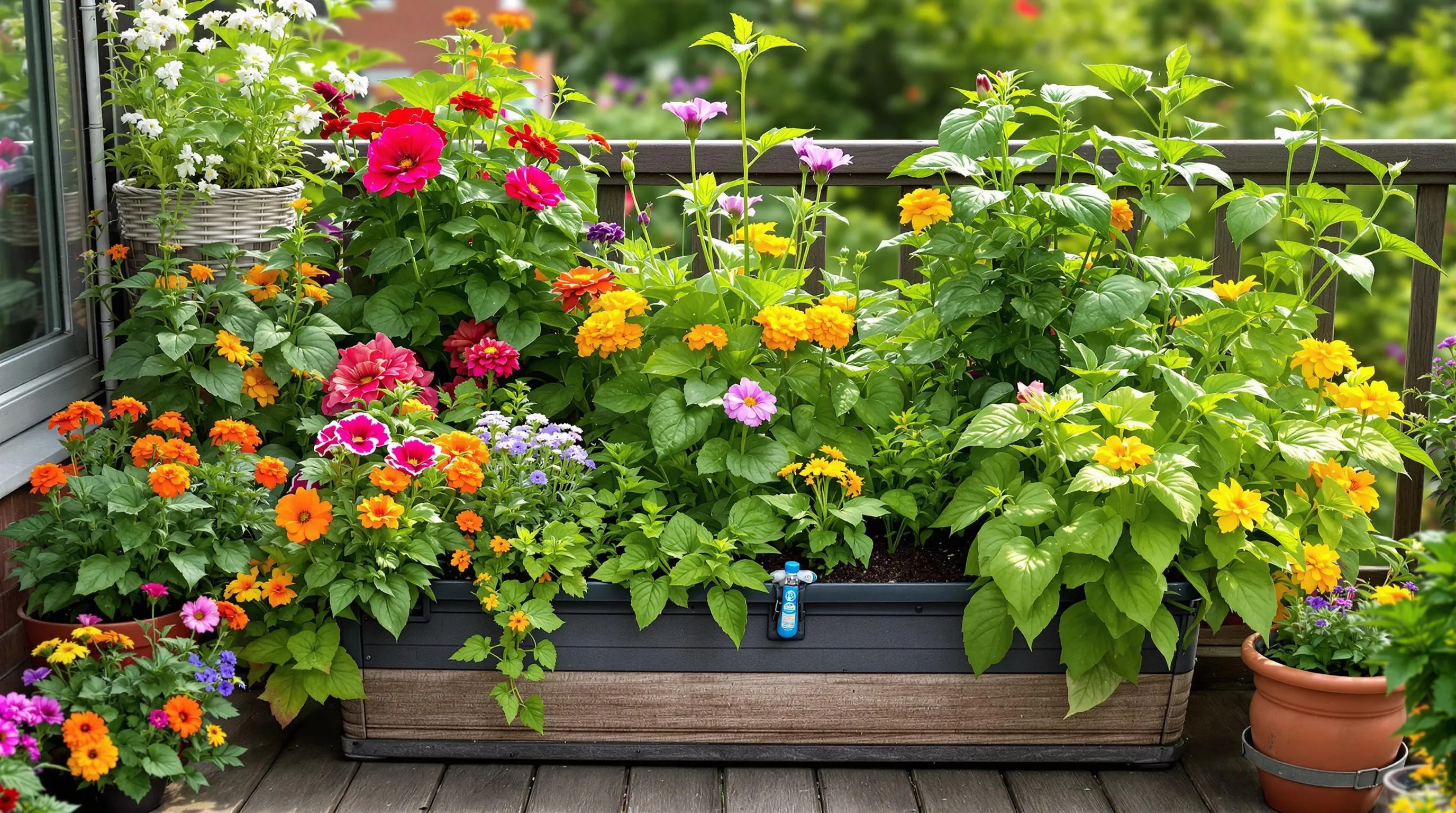
Even the smallest spaces can yield bountiful harvests with the right approach to container vegetable gardening. These compact answers let you grow fresh produce regardless of your spatial limitations.
Dwarf Varieties That Thrive in Containers
Dwarf vegetable varieties are specifically bred for container growing and deliver impressive yields in minimal space. Try ‘Patio Baby’ eggplants that produce 2-3 inch fruits on compact 18-inch plants or ‘Tiny Tim’ tomatoes that reach only 12 inches tall while bearing cherry-sized fruits. ‘Short Stuff’ carrots and ‘Baby Ball’ beets grow perfectly in containers just 6-8 inches deep. ‘Bush Pickle’ cucumbers and ‘Patio Pride’ peas offer vining vegetables without the sprawl. Look for “container-friendly” or “bush-type” varieties when selecting seeds, as these plants maintain smaller root systems while still producing full-sized or slightly smaller vegetables.
Combining Vegetables and Flowers in Small Containers
Create dual-purpose containers by pairing productive vegetables with beautiful flowers that enhance growth and deter pests. Plant trailing nasturtiums alongside bush tomatoes to repel aphids while adding vibrant color. Combine compact bush beans with marigolds to deter bean beetles and create visual interest. Pair dwarf peppers with sweet alyssum to attract beneficial insects and provide ground cover. Plant leafy greens like spinach or lettuce with calendula for pest protection and edible flower garnishes. These companion plantings maximize your limited space by providing both food and beauty while creating natural pest management systems that reduce the need for intervention.
Salad Bowl Containers
Design ready-to-harvest salad containers by grouping different leafy greens and edibles in one pot. Plant cut-and-come-again lettuce varieties like ‘Little Gem’ or ‘Tom Thumb’ around the edges with faster-growing mesclun mix in between. Add radishes, baby spinach, and arugula for texture and flavor variety. Include edible flowers like pansies or violas for color and garnish. These shallow-rooted plants thrive in containers just 6-8 inches deep, making them perfect for repurposed items like old dishpans or storage tubs. Harvest outer leaves regularly to encourage continuous production throughout the growing season.
Herb and Vegetable Combination Pots
Maximize your space by combining complementary herbs and vegetables in single containers. Plant tomatoes with basil and parsley, as they share similar water and sunlight requirements while improving each other’s flavors. Pair bush cucumbers with dill for perfect pickling companions. Combine peppers with cilantro and chives for a salsa garden in one pot. Create a Mediterranean container with compact eggplants, thyme, and oregano. These strategic combinations not only save space but also create convenient kitchen gardens where you can harvest complete recipe ingredients from a single container.
Space-Saving Vertical Vegetable Planters
Transform vertical spaces into productive vegetable gardens with specialized containers. Use tiered planters with multiple growing pockets to grow different crops in a single footprint. Try pocket hanging bags designed for strawberries but perfect for bush beans, small peppers, or herbs. Repurpose rain gutters mounted on walls or fences to grow shallow-rooted crops like lettuce, spinach, and radishes. Install trellis systems within containers to train vining crops like cucumbers and peas upward instead of spreading outward. These vertical answers can triple your growing space without requiring additional floor area.
Self-Watering Container Systems for Busy Gardeners
Self-watering containers solve the challenge of maintaining consistent moisture in small-space gardens. Use commercial self-watering planters with built-in reservoirs for thirsty crops like tomatoes and cucumbers. Create DIY self-watering systems using plastic bottles inserted into soil to deliver slow-release moisture. Try wicking systems made with cotton rope or fabric strips that pull water from a reservoir into the soil. Plant moisture-loving herbs like mint and basil alongside vegetables in these containers. These systems reduce watering frequency to once weekly while providing optimal growing conditions that prevent both drought stress and overwatering.
Micro Greens and Baby Leaf Production
Grow nutrient-dense microgreens and baby leaves in shallow containers for quick harvests in very limited spaces. Use repurposed plastic clamshells or takeout containers with drainage holes to grow microgreens like sunflower, pea shoots, or radish greens that are ready to harvest in just 7-14 days. Plant baby leaf crops like spinach, kale, and mustard greens in 4-inch deep trays for cutting at 3-4 inches tall. These space-efficient crops can grow under countertop grow lights or on bright windowsills, providing fresh greens year-round without dedicated garden space. Succession plant every 1-2 weeks for continuous harvests.
Container-Friendly Root Vegetables
Grow satisfying root crops in deep containers to maximize your vegetable garden variety. Choose 12-14 inch deep containers for round radishes, baby turnips, and compact carrot varieties like ‘Paris Market’ or ‘Thumbelina.’ Select containers at least 18 inches deep for longer root vegetables like ‘Short ‘n Sweet’ carrots or fingerling potatoes. Use fabric grow bags to prevent root circling and promote air pruning for healthier development. Plant fast-growing radishes between slower-growing root crops to maximize space usage. Harvest container-grown root vegetables slightly earlier than ground-grown counterparts for the sweetest flavor and most tender texture.
7 Mobile Container Garden Ideas for Flexible Arrangements
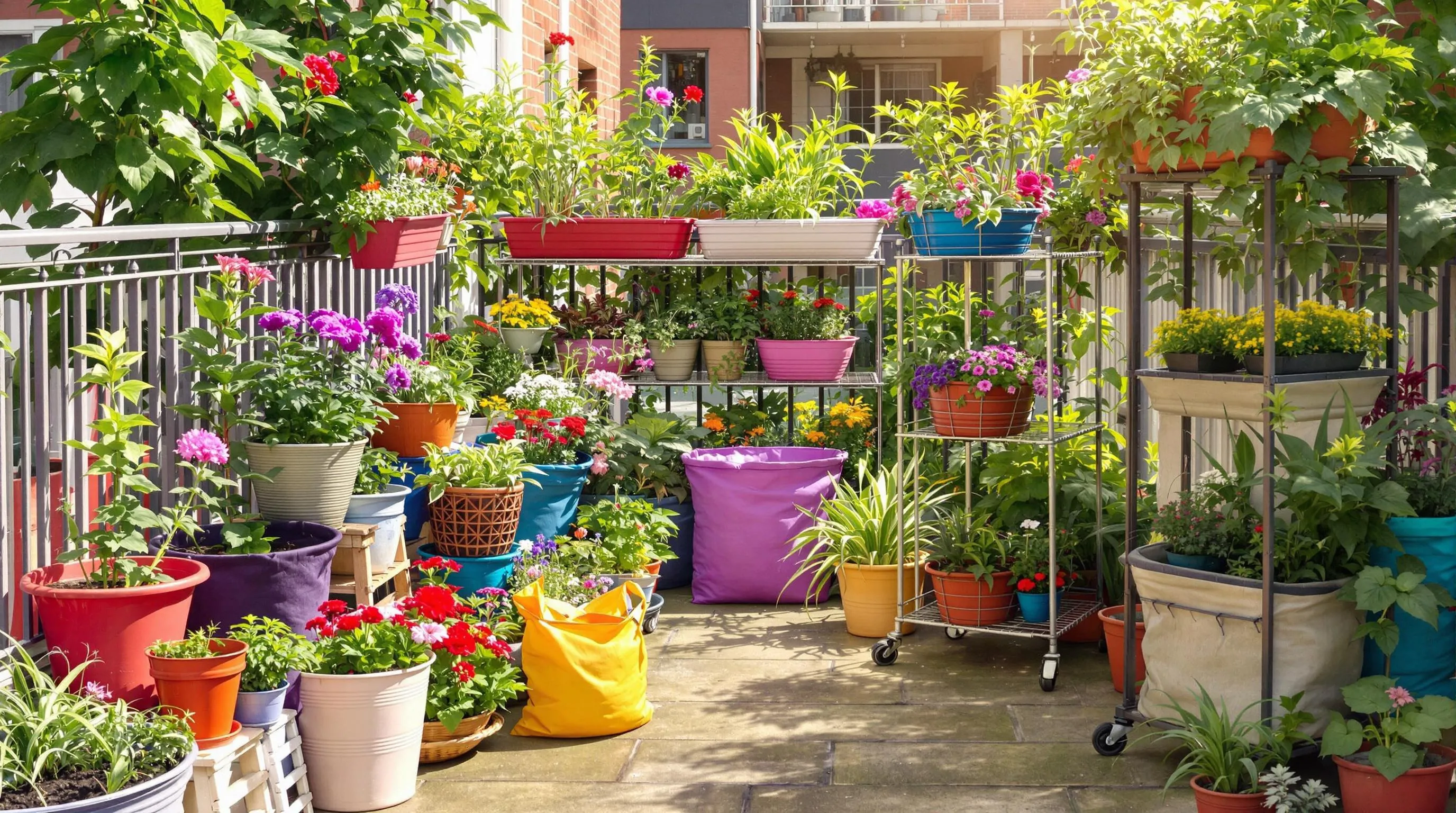
1. Wheeled Plant Caddies
Wheeled plant caddies transform heavy containers into mobile garden elements. Simply place your larger pots on these platforms with casters to easily move plants for optimal sunlight exposure throughout the day. They’re perfect for apartment dwellers who need to chase the sun as it moves across balconies or patios. Look for caddies that can support at least 80-100 pounds to accommodate medium to large containers with soil and plants.
2. Lightweight Fabric Grow Bags
Fabric grow bags offer mobility without the bulk of traditional containers. These breathable planters weigh significantly less than ceramic or concrete pots while providing excellent aeration for root systems. The handles on most grow bags make repositioning simple when weather changes or when you’re rearranging your space. Try 5-gallon bags for tomatoes or peppers and 3-gallon sizes for herbs and flowers.
3. Nesting Container Sets
Nesting container sets provide flexible arrangement options in minimal storage space. These graduated pot collections can be displayed in various configurations—clustered together, spread throughout your space, or rearranged seasonally. When not in use, they stack inside one another for compact storage. Choose sets with consistent design elements but varying heights to create visual interest in your small garden.
4. Hanging Planters with Removable Hooks
Hanging planters with removable hooks offer versatility for changing displays. Install multiple hooks around your space and simply transfer your hanging plants to different locations as needed. This system works particularly well for trailing plants like pothos or string of pearls that can serve as living decorations in various spots. Use lightweight plastic or resin containers to make moving them easier.
5. Modular Planter Systems
Modular planter systems feature interlocking containers that can be rearranged into different configurations. These systems allow you to expand or contract your garden footprint based on available space and can create different visual designs without buying new containers. Many modular systems include water reservoirs that connect between units, simplifying maintenance while maintaining flexibility.
6. Tiered Rolling Plant Stands
Tiered rolling plant stands combine vertical gardening with mobility. These multi-level carts hold many plants while occupying minimal floor space and can be wheeled to different locations as needed. Position them near windows during cold months and roll them outdoors during favorable weather. Look for stands with locking wheels to prevent unwanted movement on uneven surfaces.
7. Handled Trug Baskets
Handled trug baskets provide rustic charm with practical mobility. These shallow, wide containers traditionally used for harvesting can be repurposed as planters for shallow-rooted crops like lettuce or annual flowers. Their ergonomic handles make them easy to move around decks or balconies to catch optimal light or make space for entertaining. Line them with coco fiber to retain soil while maintaining their classic appearance.
Conclusion: Making the Most of Your Small Space Container Garden
Your small space isn’t a limitation but an opportunity for creative gardening. With these container gardening ideas you can transform any tiny area into a thriving garden that reflects your personality and meets your needs.
Remember that successful container gardening is about smart planning and vertical thinking. Start small with a few containers that excite you and gradually expand your garden as you gain confidence.
The beauty of container gardening lies in its flexibility—you can rearrange your space seasonally adjust for changing light conditions or simply refresh your layout whenever inspiration strikes. Whether you’re growing herbs for cooking vegetables for fresh harvests or flowers for beauty there’s a container solution perfect for your space.
So grab those containers upcycle what you have and start growing. Your small space garden adventure awaits!





